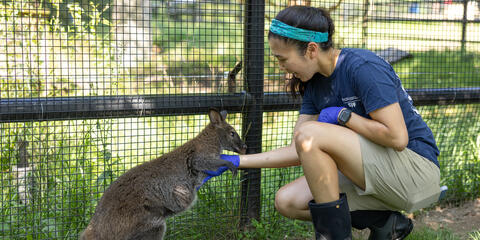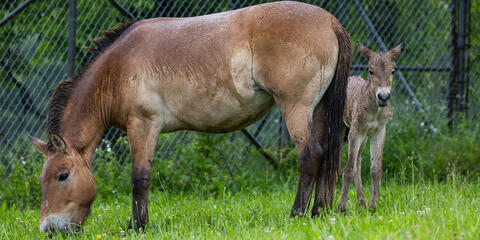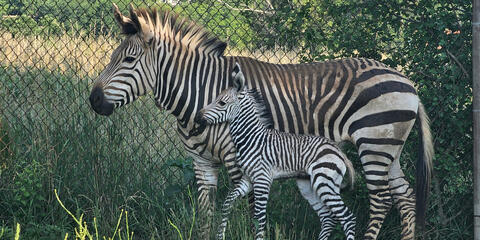Physical Description
Three-banded armadillos are various shades of brown. The hard carapace covering their bodies develops from the skin and is composed of strong, bony plates, called scutes. The tail, top of head and the outer surfaces of the limbs are also usually armored.
When frightened, they will roll up almost all the way until their armor forms a trap that snaps closed on their predator's hand or paw. The shell also helps protect them from the thorny vegetation that armadillos frequently pass through. The under surface is soft, hairy skin. The carapace is not attached to the skin on the two sides, allowing the head, legs and tail to tuck inside when the animal rolls into a ball. This works well against most predators, but unfortunately has made La Plata three-banded armadillos easy prey to human hunters.
Size
Three-banded armadillos usually weigh about 3 pounds (1.5 kilograms) and have 12-inch (30-centimeter) long bodies and 2.5-inch (6-centimeter) long tails.
Native Habitat
The range of La Plata three-banded armadillos includes parts of Bolivia, Brazil, Paraguay and Argentina. They live in open, grassy areas, open forests and marshes. They do not dig burrows like most armadillos, but use the abandoned burrows of anteaters when they can get them.
Lifespan
These armadillos usually live 15 to 20 years. While well-protected, armadillos are vulnerable to predation. Juvenile mortality can be twice that of adults; many juvenile deaths are due to predation from coyotes, bobcats, mountain lions, some raptors and even the domestic dog.
Communication
Armadillos use their sense of smell to determine the identity of other armadillos and their readiness to mate.
Food/Eating Habits
They use their well-developed sense of hearing and smell to detect both predators and prey. In the wild they feed primarily on ants and termites, which they obtain using their powerful forelegs and claws.
At the Smithsonian's National Zoo, La Plata three-banded armadillos are fed soaked insectivore diet and mealworms.
Reproduction and Development
Little information is available regarding reproduction in this species.The male's penis is one of the longest among mammals, extending two-thirds of the body length in some species. This may be necessary to extend past the carapace to the female's vaginal opening. Breeding is believed to take place between October and January. After a 120-day gestation period, females give birth to only one young that is about the size of a golf ball. Newborns look like miniature adults and become independent after 72 days.
Conservation Efforts
Loss of habitat has been substantial throughout the range of La Plata three-banded armadillos; however, this species is capable of adapting to minor modifications to its habitat. While their defense mechanism of curling into a ball is suitable for protection from natural predators, this makes them particularly susceptible to hunters and poachers, who can simply reach down and pick up the animals.
They experience high morbidity during transit, making collection for the pet trade an even greater threat to their survival. In South America, natives use armadillo carapaces to make musical instruments. These instruments, which are called charongos, are similar to mandolins.
Help this Species
- Practice ecotourism by being an advocate for the environment when you’re on vacation. During your travels, support, visit or volunteer with organizations that protect wildlife. Shop smart too! Avoid buying products made from animals, which could support poaching and the illegal wildlife trade.
- Choose your pets wisely, and do your research before bringing an animal home. Exotic animals don’t always make great pets. Many require special care and live for a long time. Tropical reptiles and small mammals are often traded internationally and may be victims of the illegal pet trade. Never release animals that have been kept as pets into the wild.
- Less is more. Cut down on the demand for resources by consuming less. Buy only what you need, and look for pre-owned or repurposed items before purchasing something brand new.
Meet the Animals
Two three-banded armadillos live in Small Mammal House.



